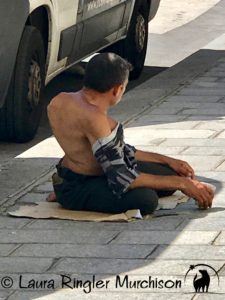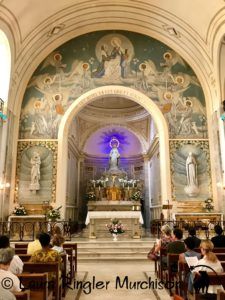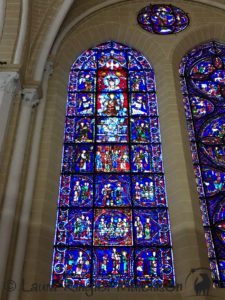
The next day we decided to revisit la Cathédral de Notre-Dame in Paris. It is the most famous of the Gothic cathedrals of the Middle Ages and is distinguished for its size, antiquity, and architectural interest. Dedicated to the Ever Blessed Virgin Mother Mary, her doors are open to over thirteen million people annually. As my feet trod upon the shadowed stone floors I reflected upon my first visit to this magnificent cathedral; it was on our honeymoon in 2007 and I remembered how very dark it was. Blackened by soot from countless years of incense, it was enshrouded in a sort of somber holiness. Hundreds of candles large and small were lit in prayer, flickering everywhere, which at once both helped to dispel the gloom and yet also contributed to it. My second trip was with our Marian child where she took her first ever independent steps, and I was surprised to see the ashy columns and ceilings had been cleaned for the cathedral’s 400 year anniversary. The entirety revealed a startling, soft white facade and I could not resist the urge to run my fingers along the smooth marble walls. The famous sculptures of the Blessed Mother were gleaming and the cathedral’s contrast — both internal and external — was as vivid as night and day. This was my fourth visit but we had yet to ascend the outside flights to the bell tower. The first time they closed before we discovered it. The second time the line was several hours long. The third time we could not take a stroller in the narrow stairway. This time we deemed our five-year-old was still too little to make the 387 steps up and then back down again without copious amounts of whining. Out of sheer frustration I hollered, “SANCTUARY!” in attempt at literary humor. I was referring of course to Victor Hugo’s 1831 French novel “The Hunchback of Notre Dame” set in Paris during the reign of Louis XI in 1482. Hugo began writing it largely to make his contemporaries more aware of the value of Gothic architecture, which was being neglected and often destroyed. A few years prior he had already published a paper entitled “War to the Demolishers,” specifically aimed at saving the city’s medieval architecture. Not knowing when we might return, I found myself standing on the cobblestones looking up with longing. “SANCTUARY!” I shouted again, as every tourist around me pretended not to notice. The word “sanctuary” is defined as being a place of refuge or safety; Merriam-Webster refers to it as a consecrated place. Religious buildings were commonly used as sanctuary and it was against the law to prevent someone from seeking asylum in a sanctuary. The hunchback of Notre-Dame was named Quasimodo and has become synonymous with “a courageous heart beneath a grotesque exterior.” It was he who called for sanctuary. Once again we left without ascending the cathedral’s towers. It is said they afford one of the best views of Paris. In addition there is an up-close look at the twelve apostles, the cathedral’s spire, and many of the gargoyles and chimera statues. The gargoyles were designed to funnel water away from the cathedral, while the chimeras are the gothic statues whose purpose is to protect the church from evil spirits. Then of course there is the infamous bell tower in which the fictional Quasimodo worked. Walking behind the famous church, we crossed the Seine to the Île Saint-Louis for some of France’s famous Berthillon ice cream. Afterward, as we made our way back across the bridge I noticed to our left there was a modern-day organ grinder. Instead of a monkey he was exploiting a little Chihuahua in a wicker basket. The man sported a beret and cranked out old French tunes from under the cover of a large blue and white umbrella. Then, almost directly across the street I discovered a man sitting upon a scant piece of cardboard, barely shielded from the sun by the shade of a parked car. He had partially removed his shirt and I was shocked to discover he had a true hunchback. His legs also appeared severely deformed and I believe he was unable to walk. As if in slow motion, I stood and watched people gravitate toward the organ grinder, giving him money while conspicuously avoiding the hunchback who was devoid of everything except a solitary paper cup. Stopping a way short of the man, whose back was to us, I asked our little girl if she would go hand him money and say, “Pour vous, monsieur.” Looking over my shoulder I found the organ grinder glaring maliciously, realizing we would not be giving him any Euros. He seemed to have amassed quite a bit of bills in the short time we had been walking. With horror I noticed as we approached the hunchbacked man he had only a single twenty cent piece at the bottom of his small cup. Here he was, in the shadow of the Cathedral of Notre-Dame, and yet everyone was literally passing him over. It was incredibly sad. The man did not push himself on anyone; rather he sat with a quiet dignity I found admirable. Before I knew it our little girl had approached him and, with great joy, said in perfect French, “For you, sir.” I will never forget the stark look of shock on the man’s face. He did not dare touch her (as if he carried some kind of contagious disease) and instead craned his head to look up at my husband. In incredulous disbelief, the curved man asked if my husband wanted his little girl to be near him. Not understanding the language, he had no idea as to what he was being asked. I interjected that our little girl wanted him to have the money. Still unsure, he looked back at our child, who was looking dejected because he had not readily taken her offering. The immediate sense of compassion this man had for her was humbling, and he asked her very gently if that was for him. I translated and she suddenly straightened. With a beaming smile — and with no hesitation or revulsion whatsoever — she bent to him to give him the money. I will be forever struck that he still took extreme care not to touch her. He smiled at her and she was so proud! Immediately I found myself ashamed; wishing we had given more. Looking up at my husband once again with astonishment, the man drew himself up to the best of his ability and thanked him in a surprisingly deep, strong voice. After we left I felt we all were profoundly blessed. This man had given so much more to us than we could have possibly given to him. As I held our little girl’s hand, I noticed she was looking back, smiling and waving good-bye to the crippled man on the street. Victor Hugo once wrote, “Adversity makes men, and prosperity makes monsters.” I would argue instead that it is avarice which makes monsters of men. Prosperity is a blessing and I believe those who have it are called to use it to help others. But in this case I can tell you the man cloaked with carousel-like music was the monster, while the “monster” was a lovely man who was in fact the real hunchback of Notre-Dame.



